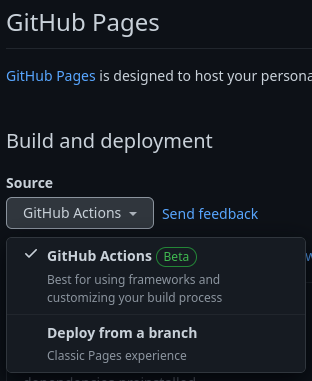Publish to GitHub Pages
Workflow
To generate your API Reference with doc2go and publish it to GitHub Pages, take the following steps.
In your GitHub project, go to Settings > Pages.
Set the Source to GitHub Actions.

In the root of your repository, create a new file at:
.github/workflows/doc2go.ymlwith the following contents:name: Publish API Reference on: # Publish documentation when a new release is tagged. push: tags: ['v*'] # Allow manually publishing documentation from a specific hash. workflow_dispatch: inputs: head: description: "Git commit to publish documentation for." required: true type: string # If two concurrent runs are started, # prefer the latest one. concurrency: group: "pages" cancel-in-progress: true jobs: build: name: Build website runs-on: ubuntu-latest steps: - name: Checkout uses: actions/checkout@v3 with: # Check out head specified by workflow_dispatch, # or the tag if this fired from the push event. ref: ${{ inputs.head || github.ref }} - name: Setup Go uses: actions/setup-go@v3 with: go-version: stable cache: true - name: Install doc2go run: go install go.abhg.dev/doc2go@latest - name: Generate API reference run: doc2go ./... - name: Upload pages uses: actions/upload-pages-artifact@v1 publish: name: Publish website # Don't run until the build has finished running. needs: build # Grants the GITHUB_TOKEN used by this job # permissions needed to publish the website. permissions: pages: write id-token: write # Deploy to the github-pages environment environment: name: github-pages url: ${{ steps.deployment.outputs.page_url }} runs-on: ubuntu-latest steps: - name: Deploy to GitHub Pages id: deployment uses: actions/deploy-pages@v1This workflow defines two triggers:
tags: This publishes the latest documentation when a new version of your library is released.workflow_dispatch: This is invoked manually from the GitHub Pages UI or the GitHub CLI to publish documentation from a specific Git commit manually.
Commit and push this file. This won’t yet publish anything because you haven’t tagged a release yet.
Trigger the workflow once manually with the tag for the most recent release of your project. You can use the GitHub CLI or the UI for this.
If you have the GitHub CLI, run the following command:
VERSION=v1.2.3 gh workflow run -f head=$VERSION doc2go.ymlBe sure to set
VERSIONto your latest release.Otherwise, open your repository on GitHub and then: Go to Actions > Publish API Reference. Click the Run workflow button at the top of the list of runs, and input the version number for your most recent release.
Chasing HEAD
The workflow above publishes from the latest tagged version. This is desirable because it keeps your API reference in sync with the latest releases.
If, for some reason, you don’t tag versions
or would prefer to report documentation from the head
of your main branch,
change the tags trigger in the workflow to the following:
on:
push:
branches: [main]
Use master above if the name of your main branch is master.
Changing the home page
The generated website includes the import path of the package in the URL.
This can result in longer URLs than desirable.
For example, for github.com/$user/$proj,
the documentation will be at:
https://$user.github.io/$proj/github.com/$user/$proj
If you’d like to change this, change the “Generate API reference” step above to:
- name: Generate API reference
run: doc2go -home github.com/${{ github.repository }} ./...
Now, the documentation for that package will be at:
https://$user.github.io/$proj/
Note
Use the import path for your module instead of the above if you’re using a vanity import path.Adding search
doc2go supports client-side search powered by Pagefind.
To add search to your documentation, follow these steps:
Install Pagefind to your repository with NPM.
npm install pagefind@latestThis will generate a package-lock.json, locking the version of Pagefind in use.
Check in the package.json and package-lock.json into your repository.
git add package.json package-lock.json git commit -m "Pin Pagefind version"In the future, you can use
npm updateto update to the latest version.In the GitHub Workflow, add steps to set up Node and download Pagefind before the “Generate API reference” step.
- name: Set up Node uses: actions/setup-node@v4 with: cache: 'npm' cache-dependency-path: package-lock.json # Specify a different cache-dependency-path if you didn't # run the command in the root of the repository. - name: Install Node dependencies run: npm installModify the command in the “Generate API Reference” step to pass the path to the newly installed Pagefind binary.
- name: Generate API reference run: doc2go -pagefind=node_modules/.bin/pagefind ./...